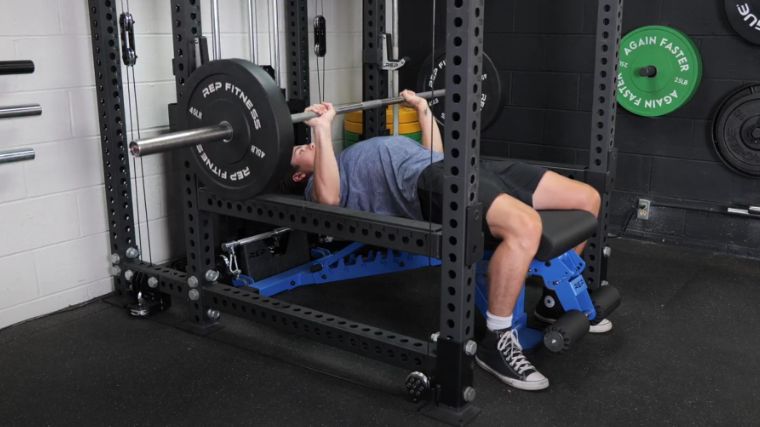Every Monday and in gyms worldwide, tribes of teenagers congregate on one of the bench press stations at their local gym. They take turns performing sets to, basically, failure. Sometimes, it’s four or five people tag-teaming the same barbell. If you’re at the back of the line, you’re probably waiting at least several minutes for your turn.
Most people consider training that way suboptimal for chest hypertrophy. A new study out of the Journal of Sports Sciences disagrees: long(er) rest periods seem to correlate to better performance in the bench press, whether training for strength or hypertrophy. (1)

[Related: We Tested and Ranked 12 of The Best Barbells]
What the Study Says
The paper published in Dec. 2023 was authored by Janićijević & colleagues and is titled, “Optimizing mechanical performance in the bench press: The combined influence of inter-set rest periods and proximity to failure.”
In short, the researchers’ data showed that rest periods of up to five minutes between sets of bench press exercises promoted better performance than resting for one or three minutes.
[Related: The Best Pre-Workout Supplements for Chest Workouts]
What They Did
Janićijević et al. took a small group of “physically active individuals” and assigned them various bench press protocols. Here’s a breakdown:
- 23 participants (15 men and 8 women) were divided into one of three groups.
- The three groups rested for either one, three, or five minutes between sets of the Smith machine bench press.
- Subjects performed six separate workouts of four sets at roughly 75% of their 1-rep max.
- For the first three workouts, participants were instructed to stop benching with roughly six reps in reserve (RIR). During the latter three workouts, participants ceased at four RIR.
- Researchers used participants’ bar velocity as a proxy for proximity to failure.
[Related: The Best Bench Press Programs for All Levels]
What They Found
Overall, the findings of this study paint a fairly intuitive picture. Longer relative rest periods support better strength training performance than brief rest, a prescription echoed by other similar studies in the past. (2)(3) But that’s not all:
This may be attributed to the different energetic resources your body relies on for bouts of activity with different durations. Your muscles and central nervous system need more time to bounce back from heavier lifting than they do from lighter, endurance-focused sets.
This finding aligns with most contemporary sports science perspectives. The more explosively you try to lift, the longer you need to rest. One essential caveat to this study is that the authors zeroed in on how rest periods influence sets not taken to absolute failure.
These findings may not apply if you bench press for as many repetitions as possible during your chest workouts. That said, training to absolute failure is not strictly required to build muscle or increase strength. (4)
Limitations
No study is without its limitations, and this paper, while valuable, shouldn’t necessarily shut the book on rest periods during bodybuilding workouts or powerlifting training sessions.
- Participant Group: With only 23 total participants, the sample size was fairly small.
- Sex Disparity: The authors recruited almost twice as many men as women, which may have colored their data somewhat.
- Exercise Selection: This study was conducted on the Smith machine bench press instead of the free-weight barbell bench.
What You Should Do
According to the authors’ remarks from the paper’s abstract, “to maintain bench press mechanical performance, five-minute inter-set rest periods are necessary when sets are terminated close to failure.”
They indicate that if you prefer to train a bit further away from failure — as in, lifting lighter weights — shorter rest periods of around three minutes won’t dampen performance much.

Taking five minutes to rest between sets doesn’t appear to harm strength or muscle-building efforts. That crowd of high schoolers you see “4v1’ing” the bench press on Monday nights might’ve been on to something after all.
More Research Content
- Intermittent Fasting May Increase Mortality Risk by 91%
- Study Argues Today’s Children Are Weaker Than Previous Generations
- Standing Calf Raises Grow More Than 2X as Much Muscle as Seated
References
- Janićijević, D., Miras-Moreno, S., Morenas-Aguilar, M. D., Moraga-Maureira, E., Weakley, J., & García-Ramos, A. (2023). Optimizing mechanical performance in the bench press: The combined influence of inter-set rest periods and proximity to failure. Journal of sports sciences, 41(24), 2193–2200.
- de Salles, B. F., Simão, R., Miranda, F., Novaes, J.daS., Lemos, A., & Willardson, J. M. (2009). Rest interval between sets in strength training. Sports medicine (Auckland, N.Z.), 39(9), 765–777.
- Senna, Gilmar W.; Willardson, Jeffrey M.; Scudese, Estevão; Simão, Roberto; Queiroz, Cristiano; Avelar, Raoni; Martin Dantas, Estélio H.. Effect of Different Interset Rest Intervals on Performance of Single and Multijoint Exercises With Near-Maximal Loads. Journal of Strength and Conditioning Research 30(3):p 710-716, March 2016.
- Grgic J, Schoenfeld BJ, Orazem J, Sabol F. Effects of resistance training performed to repetition failure or non-failure on muscular strength and hypertrophy: A systematic review and meta-analysis. J Sport Health Sci. 2022 Mar;11(2):202-211. doi: 10.1016/j.jshs.2021.01.007. Epub 2021 Jan 23. PMID: 33497853; PMCID: PMC9068575.